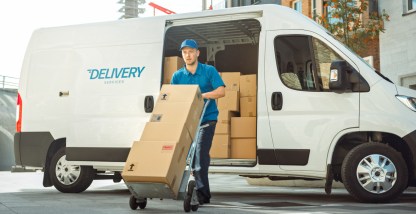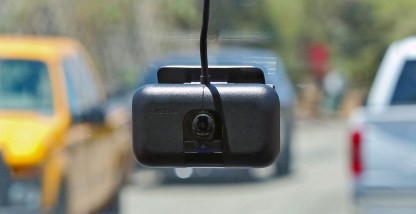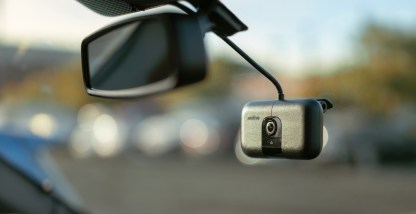Truck dash cams are small video cameras mounted on the dashboards of trucks and semi-trucks. These dash cams can be road-facing or road-facing and driver-facing.
The main purposes of these dash cams are to increase truck and driver safety, improve driver behavior, and use the video footage as evidence in case of driver exoneration. Moreover, fleets that use truck dash cams can experience increased visibility, enhance fleet safety, and improve driver accountability.
Aside from the dashboards of trucks and semi-trucks, these video cameras are often installed on the inside of the windshield or other optimal spots.
Truck and semi-truck dash cams are generally powered by the vehicles’ electrical systems. They can be manually turned on and off, or automatically activated when the ignition switch is placed in the “on” position.
Safety and fleet managers can get a holistic view of fleet safety with a combination of dash cams and fleet management software, including information such as hard braking, collision detection, hard cornering, rapid acceleration, speeding, etc.
How are dash cams used in the trucking industry?
Below are some of the common ways trucking companies can use truck dash cams:
1. Present supporting evidence for road accidents
Road accidents are among the most common reasons trucking companies get dash cams for their commercial motor vehicles.
If your trucks or semi trucks get involved in road accidents, one of the first things you want to identify is whether your vehicle was fully, partly, or not at fault.
If it was, you’d be crunching the numbers as to how much money your business may have to pay as penalties. Depending on the size of vehicles, the average figure can reach:
- $120,000 for large-truck collisions;
- $382,000 for tractor-trailer crashes;
- Up to $4.8 million if fatalities occur.
These fines are enough to financially cripple many trucking businesses.
With truck dash camera footage, you can easily identify the responsible party.
The recordings generally reveal what transpired before, during, and after the collision. This minimizes the risk of jogged memory, inaccurate and conflicting stories, and assigning the blame and the bill on the wrong party.
This also helps the authorities correctly document the incident, inspect and judge who should pay for the damages and how much.
2. Leverage truck dash cams for coaching and training
Use dash cams to train your drivers more effectively and improve your fleet safety and coaching.
Dash cameras can help you monitor new drivers or those you’re coaching to drive better. This makes driver coaching significantly easier.
You can see exactly what your driver sees when they’re behind the steering wheel — even when you’re physically not with them in the truck. From the recorded session, you can identify your driver’s faulty driving habits.
You can also use the previous truck dashcam footages to show the driving errors made and advise how your trainees can prevent similar incidents. Driving videos of other, safer drivers in your fleet can also be made a part of the driver coaching program.
Truck dash cam videos will make sure your driver training sessions are based on actual footage and hard data, instead of assumptions.
3. Motivate and reward safe driving
Truck dash cameras can also motivate truck drivers to become safer.
When you know you’re being recorded on video while driving, it makes you feel more accountable to follow the rules and best driving practices.
If you want to improve your fleet management processes and overall fleet safety, you can also create driver reward programs, provide incentives based on the dashcam footage, driver scorecards, and ELD data.
The safest commercial drivers in your fleet should get recognition and other rewards. This may not only help with driver happiness and driver retention but also encourage other drivers to drive safer on the road.
Examples of rewards include quarterly bonuses, featuring them as drivers of the month, and other performance-based incentives.
4. Boost your chances for lower insurance premium rates
Installing truck dash cams signals your insurance firms that you are seriously mindful of your truck’s and fleet’s safety. The dash cam technology helps improve driver behavior and fleet safety and reduces the chances of road accidents.
As a result, some insurance firms provide discounts and lower premiums when you install truck or semi-truck dash cams.
Different types of truck dashcams
Here are the different types of dashboard cameras you can install on your commercial trucks:
1. Standard dash cams / Road-facing dash cams / Front-facing dash cams
Standard dashboard cameras record views from the front windscreen of your commercial vehicles.
These standard in-cab vehicle cameras point out from behind the windshield, so the videos match the driver’s perspective. Vehicle owners and drivers usually install them on the vehicle dashboard or the inside of the windshield.
These gadgets are built to increase driving visibility and offer high-quality video resolution. This is why fleet management companies and those with vehicle insurance coverage often use these road-facing dash cameras.
These front-facing video cameras are also considered basic trucking dash cams and are among the cheapest cameras in the market.
2. Dual-facing dash cams
Also called “dual dashcams,” these gadgets have two cameras. One records the view of the road in front, while the other faces the truck driver.
Some dual-facing dash cams can even synchronize the two presented feeds and display them simultaneously.
With two sides of your vehicle captured at once, dual dashcams can be even more useful for reporting incidents, proving your innocence, or claiming your vehicle insurance.
Unlike road-facing dashcams, with dual-facing dashcams you can also identify and prove that your driver wasn’t distracted during a collision.
What are the best truck dash cams?
If you’re wondering what the best dash cam for truck drivers is, the answer depends on many different factors.
Here are some of the factors and qualities that you should consider when picking the best truck or semi-truck dashcam for your fleet:
- Installation. You can mount your dashboard cameras in your trucks in different ways, such as adhesives and suction cups. Adhesive attachments are excellent options as they are quick and secure. The best truck dash cam is one that is easy to set up and install.
- File storage. There are two common choices for where to store your video recordings. One is memory cards or micro SD cards, which designate a specific amount of space for your files. The other option is the cloud. This feature is available for internet-connected dash cams that automatically upload your videos to your cloud storage, so you don’t need to retrieve them manually. Internet-connected truck dash cams can also send important dash cam footage to the back-office staff in near real-time, which is very beneficial.
- Video resolution. When reviewing your footage, sharp video quality is critical for you to watch and identify persons, objects, and clips clearly.
For best viewing and recording, consider truck dash cams with a wide dynamic range (WDR) and wide-angle lens offering HD resolutions. Check out full-HD 1080p videos. High-resolution dash cam videos can help you identify important details, such as the license plates of all the vehicles involved in a collision, and whether the drivers’ eyes are open or closed.
Examine as well the quality of videos taken at night or on a very bright day. Many of the best truck dash cams in the trucking industry offer advanced video processing technologies that produce sharp visuals even in low-lighting conditions.
- Durability. The best dashcam for your semi-trucks and trucks should be high-quality and reliable, especially when you get involved in incidents and lawsuits requiring investigations by government authorities, insurance companies, and others. You can get, for instance, heavy or extreme duty dash cams and those with IP68 (waterproof and dustproof) cases.
- Ease of use. Truck dash cams are meant to improve your driving behavior and increase your safety. Truck dash cams should promote ease of use and undistracted operations, helping truckers focus their sights on the road.
- Reporting capabilities. Reporting capabilities should help you easily access important data and dash cam footage when you’re creating driver scorecards to support your training, coaching, rewards programs.
- Smart features. Some dash cameras use AI to glean more in-depth data and insights that they can use in coaching and other activities to improve their fleet truckers’ driving behaviors.
AI-detection and smart data are very critical aspects of fleet safety. Without full context, you can’t always judge a driver’s performance and the decisions he made on the road. For example, what if the weather was bad? What about the conditions of the road? Were there any maintenance problems with the vehicle?
There are many factors that are involved. If you want to learn more, read about Motive’s Safety Hub and how it is improving fleet safety for our customers.
Dashcam checklist
When looking for the best commercial truck dashcam for your fleet, consider this checklist of features:
- Loop recording;
- Parking modes or monitors;
- Inbuilt sensors: G-force for crash detection, GPS, accelerometer, etc.
- High-quality resolution and sophisticated video processing features for whether night-time or daytime recordings;
- LTE or WiFi connectivity for network-connected dash cams;
- Secure video file storage and backup batteries;
- Date and time stamps (critical with GPS location details when footages serve as evidence).
- Full integration with your ELD and fleet management software.
Ready to leverage commercial truck dash cams?
Operating with truck and semi-truck dash cams go a long way in enhancing your fleet and road safety. Investing in a Smart Dashcam or AI Dashcam can help protect your business resources and offers other practical benefits.
If you want to see how truck dash cams can improve your fleet safety, check out the Motive Smart Dashcam and request a free demo.








